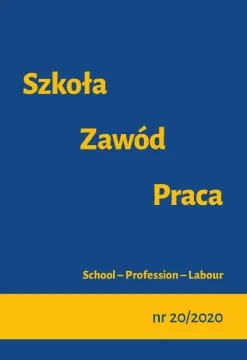Types of education and career-related activity of young people seeking employment on the Internet
DOI:
https://doi.org/10.34767/SZP.2020.02.18Keywords:
labour market, people seeking employment, jobseekers, young unemployed people, education – and career-related activity, the InternetAbstract
The article is of theoretical and empirical character. Issues are raised in it pertaining to the education – and career-related activities of young people seeking employment on the Internet. On the basis of source literature, key concepts have been defined, and the situation in the labour market has been presented. The results of a survey conducted in the years 2018‒2019 have been provided, which aimed to identify the types of education – and career-related activities of young people (up to 30 years of age), both unemployed and those not eligible for the status of an unemployed person (employed and unemployed) on the Internet. A number of forms of activities were analysed, starting with seeking information being essential from the point of view of the educational market and the labour market, through contacts with career counsellors, employment agents, employers and other persons, up to participation in discussions taking place on the Internet dealing with education – and career-related subjects. It follows from the analysis that the types of education – and career-related activities of young people seeking employment on the Internet focus mainly on the following: information on job and educational offers, situation in the labour market, contacts with employers, browsing educational and vocational websites. Unfortunately, young people very rarely visited the websites of institutions providing support with respect to educational and vocational issues and only occasionally contacted specialists in this field.
References
Klementowska, A. E-generacja a aktywność edukacyjno-zawodowa w sieci. Technika a Vzdelavanie, vol. 6, no 2 (2017).
Klementowska, A., Flaszyńska, E. (2018). Rynek pracy a zmiany pokoleniowe (stan i prognozy). Zielona Góra: UZ – IIBNP, PTP.
Kruczkowska, E. (2016). Czy państwo i rynek pracy nadążają za rewolucją technologiczną. W: M. Tanaś (red.), Nastolatki wobec Internetu. Warszawa: NASK & Maciej Tanaś.
Plewka, C. (2017a). Potrzeby i oczekiwania pracodawców współczesnego rynku pracy – wyzwania, bariery, kierunki działań. W: C. Plewka (red.), Wybrane aspekty dotyczące człowieka współczesnej cywilizacji. Koszalin: PK.
Plewka, C. (2017b). Pracownik współczesnego rynku pracy to osoba głównie…? W: A. Klementowska, B. Pietrulewicz (red.), Edukacja i praca w procesie rozwoju zawodowego. Zielona Góra: PTP, IIBNP, UZ.
Skórska, A. (2016). Rynek pracy. Wybrane zagadnienia. Katowice: UE.
Stopa bezrobocia młodych, Rynek pracy.org, https://rynekpracy.org/statystyki/stopa-bezrobocia-mlodych/ (10.01.2020).
Stopa rejestrowanego bezrobocia w latach 1990-2019, Główny Urząd Statystyczny, https://stat.gov.pl/obszary-tematyczne/rynek-pracy/bezrobocie-rejestrowane/stopa-bezrobocia-rejestrowanego-w-latach-1990-2019,4,1.html (07.01.2020).
Szaban, J.M. (2016). Rynek pracy w Polsce i w Unii Europejskiej, wyd. 2. Warszawa: Difin.
Ustawa z 20 kwietnia 2004 r. o promocji zatrudnienia i instytucjach rynku pracy (Dz.U. z 2004 r. Nr 99, poz. 1001).
Ustawa z 14 marca 2014 r. o zmianie ustawy o promocji zatrudnienia i instytucjach rynku pracy oraz niektórych innych ustaw (Dz.U. z 2014 r., poz. 598).
Wortal Publicznych Służb Zatrudnienia, https://psz.praca.gov.pl/-/920001-czym-rozni-sie-status-poszukujacego-pracy-od-statusu-bezrobotnego – (16.01.2020).

